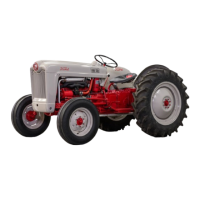FO-4 I&T (Remastered Ver.1.2 ) 05-24-2015
diameters to permit obtaining a free but minimum-clearance-fit of the valve in the
bushing (24). When checking the fit, valve and the bushing should be coated with
hydraulic oil which is the same lubricant used in the transmission. Obtain minimum
clearance by selection from the available valves:
Part No. Diameter Color
8N698E .5917-.5918 White
8N698F .5918-.5920 Blue
8N698G .5920-.5921 Yellow
Valve bushing is available in standard bore size only but can be obtained .010
oversize on the outside diameter. Be sure to use latest bushing which has 4 intake
holes. Bushing should not be sized after installation and should be pressed in
flush with the face of the pump base. Turn bushing to position where cotter pin
hole is approximately horizontal so as to facilitate insertion of the locking
cotter pin.
118. EXHAUST CONTROL VALVE. Exhaust control valve (34-Fig. FO94) and its bushings
(B) in the pump base should be free of scratches. Valve should move freely in
bushing but should have minimum clearance when checked with the recommended
transmission oil on the valve and bushing. Exhaust valve is available in 5
diameters as follows:
Part No. Diameter Color
8N640A2 .5917-.5918 White
8N640B .5919-.5920 Blue
8N640C .5920-.5921 Yellow
8N640D .5923-.5924 Green
8N640E .5925-.5926 Orange
Bushing (B) for exhaust control valve is pressed into pump base and should be
renewed if scratched or otherwise damaged. Bushing should not be sized after
installation. It should be installed flush with face of pump base and with holes in
such position as to assure easy insertion of the locking cotter pin. Bore diameter
of bushing is .5926.
119. SAFETY AND CHECK VALVE UNIT. A check valve (32-Fig. FO94) is combined with
the safety (relief) valve (30) mounted in the pump base. The safety valve is
factory adjusted to unseat at a minimum pressure of 1600 psi. if any parts of this
valve are worn or broken or show signs of leakage, install a new valve unit.
Inspect the check valve for signs of leakage. Improper seating may be due to
irregularities of the seat in the pump base which can be corrected by using the
special Ford reseating tool or equivalent as shown in Fig. FO96. Leakage signs on
the valve (32-Fig. FO94) can be corrected by renewal of the valve, followed by
lapping if necessary.
Connect/Report Errors – jcchapster@gmail.com

